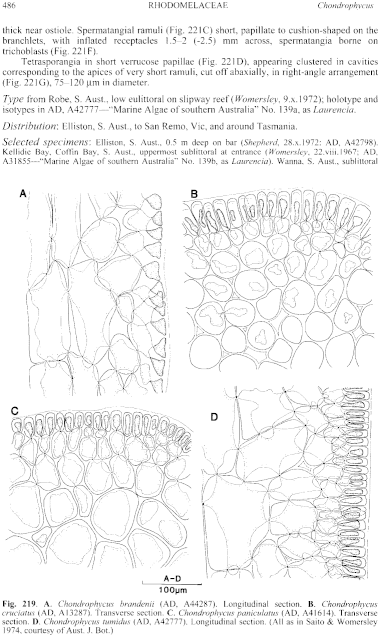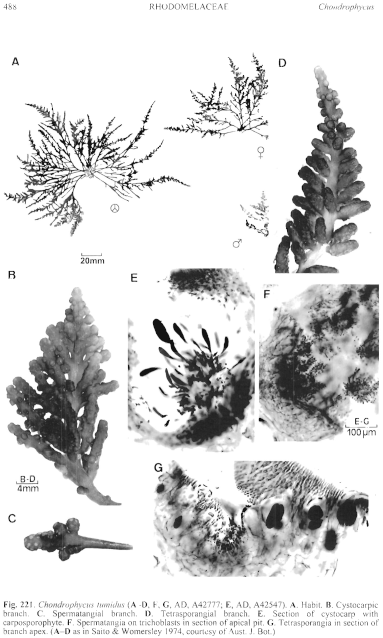|
|
|
|
|
|||||||||||
|
Electronic Flora of South Australia Species Fact Sheet
Phylum Rhodophyta – Family Rhodomelaceae – Tribe Laurencieae
Selected citations: Nam 1999: 466.
Synonym
Laurencia tumida Saito & Womersley 1974: 846, figs 5E, F, 26, 27. Shepherd & Womersley 1981: 369.
Thallus (Fig. 221A) dark brown-red, robust, firm, cartilaginous, (2–) 10–15 cm high, with one to several axes, little-branched when young, becoming much-branched radially for 2–3 orders and pyramidal in form when mature; branches terete, axes (1–) 1.5–2 (–3.5) mm in diameter, slightly tapering basally, lesser branches 1.5–2.5 mm in diameter. Holdfast discoid, thin, 2–10 mm across; epilithic. Structure. Epidermal cells 12–20 µm across, isodiametric to slightly elongate, compact, scarcely elongating below, without secondary pit-connections or corps en cerise; in section (Fig. 219D), epidermal cells elongate and palisade-like, L/D 1.5–2.5, cortical cells compact, without lenticular thickenings. Cells with elongate rhodoplasts, ribbon-like and reticulate in cortical cells.
Reproduction: Gametophytes dioecious. Procarps not observed. Carposporophytes (Fig. 221E) with a basal fusion cell and branched gonimoblast bearing clavate terminal carposporangia 20–40 in diameter. Cystocarps (Fig. 221B) largely immersed, forming slight to hemispherical mounds on lesser branches, 0.7–1 mm across; pericarp ostiolate, several cells thick near ostiole. Spermatangial ramuli (Fig. 221C) short, papillate to cushion-shaped on the branchlets, with inflated receptacles 1.5–2 (–2.5) mm across, spermatangia borne on trichoblasts (Fig. 221F).
Tetrasporangia in short verrucose papillae (Fig. 221D), appearing clustered in cavities corresponding to the apices of very short ramuli, cut off abaxially, in right-angle arrangement (Fig. 221G), 75–120 µm in diameter.
Type from Robe, S. Aust., low eulittoral on slipway reef (Womersley, 9.x.1972); holotype and isotypes in AD, A42777-"Marine Algae of southern Australia" No. 139a, as Laurencia.
Selected specimens: Elliston, S. Aust., 0.5 m deep on bar (Shepherd, 28.x.1972: AD, A42798). Kellidie Bay, Coffin Bay, S. Aust., uppermost sublittoral at entrance (Womersley, 22.viii.1967; AD, A31855-"Marine Algae of southern Australia" No. 139b, as Laurencia). Wanna, S. Aust., sublittoral fringe (Kraft, 11.xi.1971; AD, A42179). Edithburg, S. Aust., 1 m deep on jetty pylons (Johnson, 31.v.1984; A55527). Encounter Bay, S. Aust. (Womersley, 4.vi.I 943; AD, A1777). "Gypsum wharf', Ballast Head, Kangaroo I., S. Aust., 0.5 m deep (Kraft, 16.vii.1972; AD, A42519). Vivonne Bay, Kangaroo I., S. Aust., lower eulittoral on jetty (Kraft, 15.vii.I 972; AD, A42547). Pennington Bay, Kangaroo I., S. Aust. (Saito, 4.iv.1972; AD, A41971). Lawrence Rock, Vic., in rock pools (Beauglehole, 15.i.1960; AD, A24796). Warrnambool, Vic., on reef (Shepherd, 19.viii.1972; AD, A42627). Cape Nelson, Vic., mid eulittoral pool (Womersley, 2.ix.1971; AD, A39539). Crawfish Rock, Westernport Bay, Vic., 0 m deep (Watson, 17.xi.1974; AD, A46219). San Remo, Vic., drift (Sinkora A723, 15.viii.1970; AD, A41362). Mallacoota, Vic. (Herada, 13.xi.1977; AD, A52552). Rocky Cape, NW Tas., lower eulittoral pools (Womersley, 17.x.1982; AD, A55548). Low Head, Tas., upper sublittoral (Cribb 74.9, 16.ix.1950; AD, A16304). Tessellated Pavements, Eaglehawk Neck, Tas., low eulittoral (Gordon, 13.i.1966; AD, A30078).
Distribution: Elliston, S. Aust., to San Remo, Vic, and around Tasmania.
Taxonomic notes: Chondrophycus tumidus is a distinctive species occurring near to low tide level on coasts of moderate roughness, characterised by its robust thallus with extremely short branches bearing reproductive structures.
References:
GARBARY, D.J. & HARPER, J.T. (1998). A phylogenetic analysis of the Laurencia complex (Rhodomelaceae) of the red algae. Cryptogamie, Algol. 19, 185–200.
NAM, K.W. (1999). Morphology of Chondrophycus undulata and C. parvipapillata and its implications for the taxonomy of the Laurencia (Ceramiales, Rhodophyta) complex. Eur. J. Phycol. 34, 455–468.
SAITO, Y. & WOMERSLEY, H.B.S. (1974). The southern Australian species of Laurencia (Ceramiales: Rhodophyta). Aust. J. Bot. 22, 815–874.
SHEPHERD, S.A. & WOMERSLEY, H.B.S. (1981). The algal and seagrass ecology of Waterloo Bay, South Australia. Aquat. Bot. 11, 305–371.
The Marine Benthic Flora of Southern Australia Part IIID complete list of references.
Publication:
Womersley, H.B.S. (24 February, 2003)
The Marine Benthic Flora of Southern Australia
Rhodophyta. Part IIID. Ceramiales – Delesseriaceae, Sarcomeniaceae, Rhodomelaceae
Reproduced with permission from The Marine Benthic Flora of Southern Australia Part IIID 2003, by H.B.S. Womersley. Australian Biological Resources Study, Canberra. Copyright Commonwealth of Australia.
Illustrations in Womersley Part IIIA, 2003: FIGS 219D, 221.

Figure 219 enlarge
Fig. 219. A. Chondrophycus brandenii (AD, A44287). Longitudinal section. B. Chondrophycus cruciatus (AD, A13287). Transverse section. C. Chondrophycus paniculatus (AD, A41614). Transverse section. D. Chondrophycus tumidus (AD, A42777). Longitudinal section. (All as in Saito & Womersley 1974, courtesy of Aust. J. Bot.)

Figure 221 enlarge
Fig. 221. Chondrophycus tumidus (A–D, F, G, AD, A42777; E, AD, A42547). A. Habit. B. Cystocarpic branch. C. Spermatangial branch. D. Tetrasporangial branch. E. Section of cystocarp with carposporophyte. F. Spermatangia on trichoblasts in section of apical pit. G. Tetrasporangia in section of branch apex. (A–D as in Saito & Womersley 1974, courtesy of Aust. J. Bot.)

|
Email Contact: State Herbarium of South Australia |

|